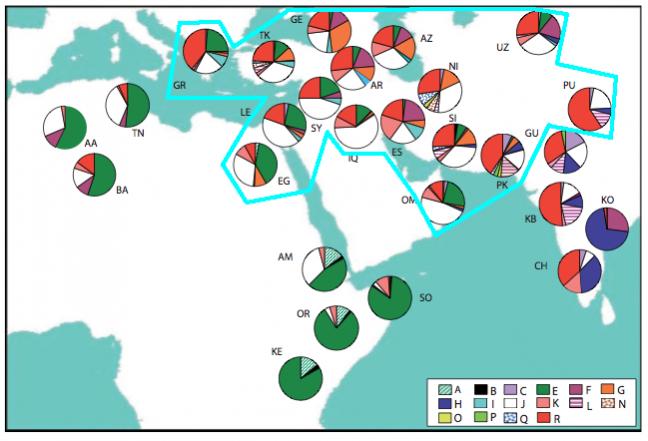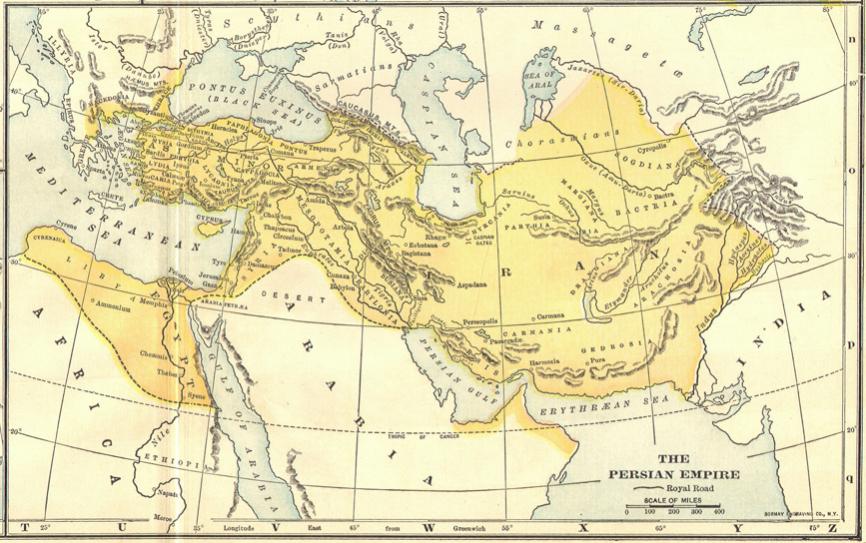Re: Iranian-Armenian relations
Can we rename this thread Iranian-Armenian [Sexual]-Relations? 
Let me quote from the DNA study you sent: "The Armenian modal hg1 haplotype (haplotype 1), prevalent particularly in the Syunik, Karabakh and Iranian regions."
DNA LEGACY OF THE PERSIAN EMPIRE - NOTICE THAT PERSIAN, ARMENIAN, GEORGIAN, OSSETIAN DNA ARE THE CLOSEST MATCH.

ES = CENTRAL IRAN; NI = NORTHERN IRAN; SI = SOUTHERN IRAN.
A FEW NOTES TO MAKE THIS EASIER TO UNDERSTAND:
* Remember that Iraq is a country that was created by the British simply by drawings lines on the maps of the Persian Empire; at the time Iraq was created it had briefly been conquered by the Ottomans, but prior to that was a historical part of the Persian empire. Iraq was created in 1932, following World War I.
* Green is Afro-Semitic Influence.
* Dark Blue is Indian Influence.
* Aryans spread their genes as far as the Southern Part of India as far West as Libya and throughout Europe (on this map).
Compare with the DNA Distribution Above:

Another way of reading the above DNA distribution is that there is absolutely no merit to the Ottoman/Pan-Turkist stories of their origins. (But we already knew that.) Mos, I'm sure you will have many sleepless nights worrying how much GREEN and PURPLE you personally have, but the best way to consider this information is to not freak out and think about it step-by-step.
Anthem of the Aryans (Ey Iran)
Inscription Left By The Aryan King Darius:
"I am Darius the great king, king of kings, king of countries containing all kinds of men, king in this great earth far and wide, son of Hystaspes, an Achaemenid, a Persian, son of a Persian, an Aryan, having Aryan lineage. By the favor of Ahuramazda these are the lands of the Aryans; I ruled over them; they bore tribute to me; they held my law firmly; Media, Elam, Parthia, Aria, Bactria, Sogdia, Chorasmia, Drangiana, Arachosia, Sattagydia, Gandara, India, the haoma-drinking Scythians, the Scythians with pointed caps, Babylonia, Assyria, Arabia, Egypt, Armenia, Cappadocia, Lydia, the Greeks, the Scythians across the sea, Thrace, the sun hat-wearing Greeks, the Libyans, the Nubians, the men of Maka and the Carians." http://www.livius.org/da-dd/darius/darius_i_t01.html
From the Bible: [Isaiah 45.1-8] (Cyrus the Great is the only Gentile in the Bible Referred to as the "Messiah.")
"Thus says the Lord to His anointed Messiah, to Cyrus to subdue nations before him and loose the armor of kings, to open before him the double doors, so that the gates will not be shut: 'I will go before you and make the crooked places straight; I will break in pieces the gates of bronze and cut the bars of iron. I will give you the treasures of darkness and hidden riches of secret places."
Who are the Ossetians?
By: Dr Oric Basirov 2001.
"As late as the closing decades of the 4th century B.C., the Iranian peoples were still the largest and the most widespread group within the great Indo-European family.... Fortunately for us, the Huns could not push all the Alans out of their homeland; their descendants, known as Ossets, are the only Iranians who still live in Europe; they call their country "Iron", which is a variation of Alan, Iran, as well as Eran. Eran [Arran] was the name of the Iranian Transcaucasia before it was lost to the Russians in the 19th century and subsequently renamed Azarbaijan.
Ossets are mostly Christian, speaking Ossetic, or as they themselves call it "Ironig", or "Ironski", which is classified as an Eastern Iranian language. Ossetic maintains on the one hand, some remarkable features of the Gathic Avestan, and possesses on the other, a number of words, such as, thau (tauen, to thaw, as in snow) and gau (region, district) which are remarkably similar to their modern Germanic equivalents.
This modern Iranian nation, still provides a physical link between the Indo-Europeans of the East, and those of the West, that is, most people of Europe; such a romantic link, it will be remembered, had already been established thousands of years ago by their blond and blue-eyed ancestors."
http://ossetians.com/eng/news.php?newsid=545
What's the point of all this? I think there's a lot to be learned about Armenian history from the period of antiquity by studying Persian history.
Originally posted by Mos
View Post

Let me quote from the DNA study you sent: "The Armenian modal hg1 haplotype (haplotype 1), prevalent particularly in the Syunik, Karabakh and Iranian regions."
DNA LEGACY OF THE PERSIAN EMPIRE - NOTICE THAT PERSIAN, ARMENIAN, GEORGIAN, OSSETIAN DNA ARE THE CLOSEST MATCH.
ES = CENTRAL IRAN; NI = NORTHERN IRAN; SI = SOUTHERN IRAN.
A FEW NOTES TO MAKE THIS EASIER TO UNDERSTAND:
* Remember that Iraq is a country that was created by the British simply by drawings lines on the maps of the Persian Empire; at the time Iraq was created it had briefly been conquered by the Ottomans, but prior to that was a historical part of the Persian empire. Iraq was created in 1932, following World War I.
* Green is Afro-Semitic Influence.
* Dark Blue is Indian Influence.
* Aryans spread their genes as far as the Southern Part of India as far West as Libya and throughout Europe (on this map).
Compare with the DNA Distribution Above:
Another way of reading the above DNA distribution is that there is absolutely no merit to the Ottoman/Pan-Turkist stories of their origins. (But we already knew that.) Mos, I'm sure you will have many sleepless nights worrying how much GREEN and PURPLE you personally have, but the best way to consider this information is to not freak out and think about it step-by-step.
Anthem of the Aryans (Ey Iran)
Inscription Left By The Aryan King Darius:
"I am Darius the great king, king of kings, king of countries containing all kinds of men, king in this great earth far and wide, son of Hystaspes, an Achaemenid, a Persian, son of a Persian, an Aryan, having Aryan lineage. By the favor of Ahuramazda these are the lands of the Aryans; I ruled over them; they bore tribute to me; they held my law firmly; Media, Elam, Parthia, Aria, Bactria, Sogdia, Chorasmia, Drangiana, Arachosia, Sattagydia, Gandara, India, the haoma-drinking Scythians, the Scythians with pointed caps, Babylonia, Assyria, Arabia, Egypt, Armenia, Cappadocia, Lydia, the Greeks, the Scythians across the sea, Thrace, the sun hat-wearing Greeks, the Libyans, the Nubians, the men of Maka and the Carians." http://www.livius.org/da-dd/darius/darius_i_t01.html
From the Bible: [Isaiah 45.1-8] (Cyrus the Great is the only Gentile in the Bible Referred to as the "Messiah.")
"Thus says the Lord to His anointed Messiah, to Cyrus to subdue nations before him and loose the armor of kings, to open before him the double doors, so that the gates will not be shut: 'I will go before you and make the crooked places straight; I will break in pieces the gates of bronze and cut the bars of iron. I will give you the treasures of darkness and hidden riches of secret places."
Who are the Ossetians?
By: Dr Oric Basirov 2001.
"As late as the closing decades of the 4th century B.C., the Iranian peoples were still the largest and the most widespread group within the great Indo-European family.... Fortunately for us, the Huns could not push all the Alans out of their homeland; their descendants, known as Ossets, are the only Iranians who still live in Europe; they call their country "Iron", which is a variation of Alan, Iran, as well as Eran. Eran [Arran] was the name of the Iranian Transcaucasia before it was lost to the Russians in the 19th century and subsequently renamed Azarbaijan.
Ossets are mostly Christian, speaking Ossetic, or as they themselves call it "Ironig", or "Ironski", which is classified as an Eastern Iranian language. Ossetic maintains on the one hand, some remarkable features of the Gathic Avestan, and possesses on the other, a number of words, such as, thau (tauen, to thaw, as in snow) and gau (region, district) which are remarkably similar to their modern Germanic equivalents.
This modern Iranian nation, still provides a physical link between the Indo-Europeans of the East, and those of the West, that is, most people of Europe; such a romantic link, it will be remembered, had already been established thousands of years ago by their blond and blue-eyed ancestors."
http://ossetians.com/eng/news.php?newsid=545
What's the point of all this? I think there's a lot to be learned about Armenian history from the period of antiquity by studying Persian history.










Comment